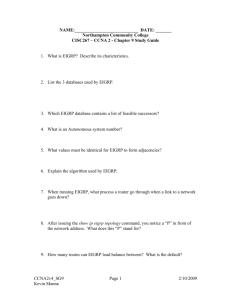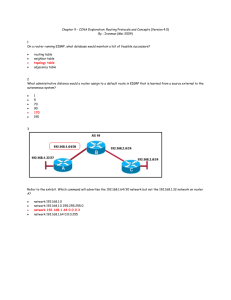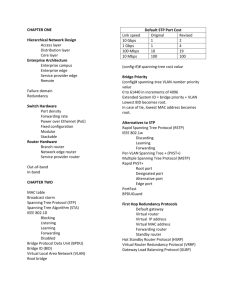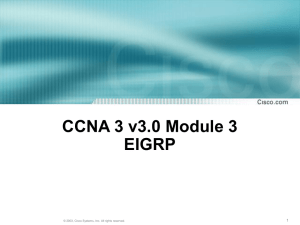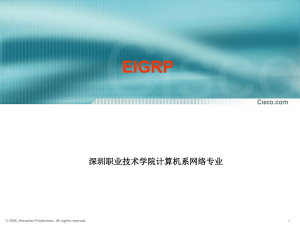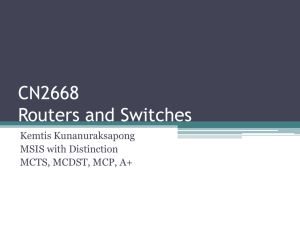Untitled - LearnSmart
advertisement
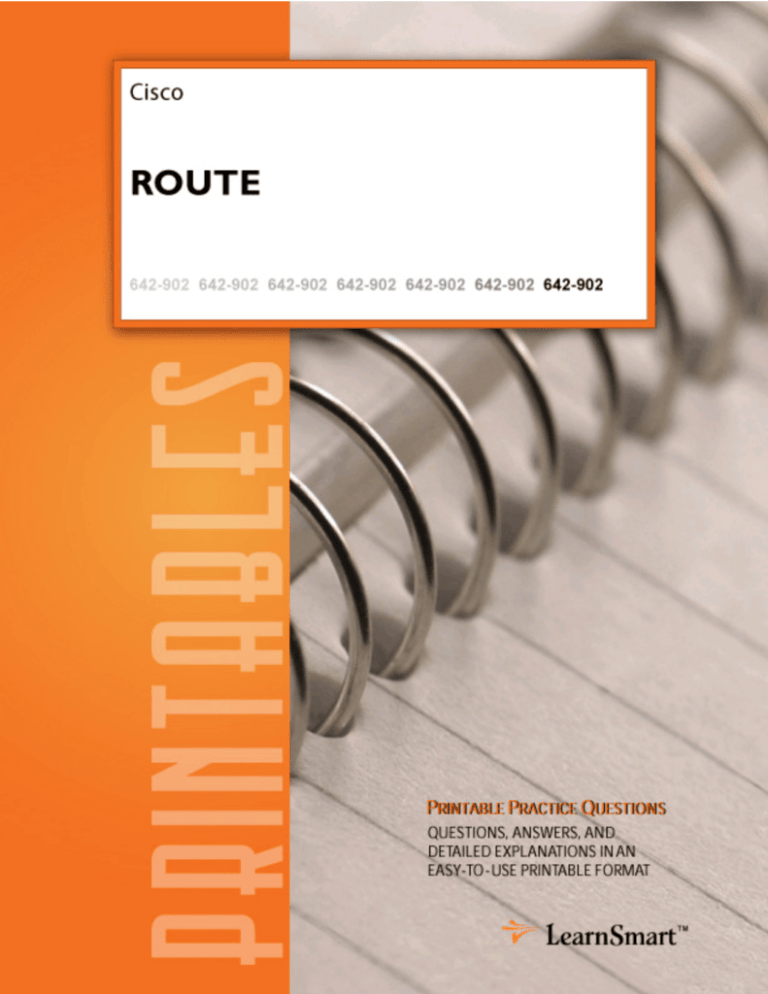
Implement an EIGRP based solution, given a network design and a set of requirements Chapter 1 Implement an EIGRP based solution, given a network design and a set of requirements 1. A network engineer is on a router that is running EIGRP in ASN 100. They configure the following command on interface fa0/0:ip hold-time eigrp 100 10After this command was entered, the EIGRP neighbor relationship fails on fa0/0. Why did this happen?Choose the best answer. ❍ A. ❍ B. ❍ C. ❍ D. The EIGRP hello timers do not match a neighbor connected to fa0/0. The engineer must perform a shutdown and then a no shutdown to bring the EIGRP neighbor relationship back. The EIGRP hold timers do not match on a neighbor connected to fa0/0. You cannot modify EIGRP hold timers on broadcast networks such as Ethernet. Find the Answer p. 73 2. Which of the following configuration settings is NOT required to match when configuring EIGRP neighbor interfaces?Choose the best answer. ❍ ❍ ❍ ❍ A. B. C. D. EIGRP authentication key number EIGRP passive interface mode EIGRP hello timer EIGRP hold timer Find the Answer p. 73 2 Implement an EIGRP based solution, given a network design and a set of requirements 3. You are troubleshooting an EIGRP authentication problem that is preventing an EIGRP neighbor relationship from forming.You run the following debug command:debug eigrp packetYou see the following debug output:*Jan 21 16:50:18.749: EIGRP: pkt key id = 2, authentication mismatch*Jan 21 16:50:18.749: EIGRP: Serial0/0/1: ignored packet from 192.168.1.101, opc ode = 5 (invalid authentication)*Jan 21 16:50:18.749: EIGRP: Dropping peer, invalid authentication*Jan 21 16:50:18.749: EIGRP: Sending HELLO on Serial0/0/1 *Jan 21 16:50:18.749: AS 100, Flags 0x0, Seq 0/0 idbQ 0/0 iidbQ un/rely 0/0*Jan 21 16:50:18.753: %DUAL-5-NBRCHANGE: IP-EIGRP(0) 100: Neighbor 192.168.1.101 (Serial0/0/1) is down: Auth failureGiven the debug output, what is likely the problem?Choose the best answer. ❍ A. ❍ ❍ ❍ ❍ B. C. D. E. One neighbor is using MD5 authentication while the other is using clear-text authentication. The authentication key numbers do not match. The MD5 passwords do not match. Authentication is not configured on the remote router. Authentication is not configured on the local router. Find the Answer p. 73 4. Gi0/0 is enabled with an IP address of 192.168.18.20/28. You want to configure this interface to participate in EIGRP that is enabled on the router. What EIGRP network statement below is valid?Choose the best answer. ❍ ❍ ❍ ❍ A. B. C. D. network 192.168.18.0 0.0.0.7 network 192.168.18.16 0.0.0.3 network 192.168.18.0 0.0.0.15 network 192.168.18.0 0.0.0.7 Find the Answer p. 73 3 Implement an EIGRP based solution, given a network design and a set of requirements 5. A network engineer is configuring EIGRP and enters the following network statement:network 162.18.3.0What wildcard mask would be applied to this network statement by default?Choose the best answer. ❍ ❍ ❍ ❍ A. B. C. D. 255.255.0.0 0.0.0.255 255.0.0.0 0.0.255.255 Find the Answer p. 73 6. Which EIGRP show command lists the working interfaces that EIGRP is currently enabled on?Choose the best answer. ❍ ❍ ❍ ❍ ❍ A. B. C. D. E. show ip eigrp interfaces show eigrp interfaces show ip eigrp topology show eigrp topology show ip interface brief Find the Answer p. 73 7. How does an EIGRP router send topology information to neighbors?Choose the best answer. ❍ ❍ ❍ ❍ A. B. C. D. Multicast message to 224.0.0.10 Broadcast message to 255.255.255.255 Multicast message to 224.0.0.5 Multicast message to 224.0.0.6 Find the Answer p. 73 4 Implement an EIGRP based solution, given a network design and a set of requirements Answers: Chapter 1 1. C Review Question p. 2 Detailed Explanation p. 83 2. A Review Question p. 2 Detailed Explanation p. 83 3. B Review Question p. 3 Detailed Explanation p. 83 4. C Review Question p. 3 Detailed Explanation p. 84 5. D Review Question p. 4 Detailed Explanation p. 84 6. A Review Question p. 4 Detailed Explanation p. 85 7. A Review Question p. 4 Detailed Explanation p. 85 8. C Review Question p. 5 Detailed Explanation p. 85 9. E Review Question p. 5 Detailed Explanation p. 86 10. A, D Review Question p. 6 Detailed Explanation p. 86 11. C Review Question p. 6 Detailed Explanation p. 87 12. C Review Question p. 7 Detailed Explanation p. 87 13. B, D Review Question p. 7 Detailed Explanation p. 87 14. C Review Question p. 8 Detailed Explanation p. 88 15. C Review Question p. 8 Detailed Explanation p. 88 16. C Review Question p. 8 Detailed Explanation p. 89 17. B Review Question p. 9 Detailed Explanation p. 89 18. A Review Question p. 9 Detailed Explanation p. 89 19. D Review Question p. 9 Detailed Explanation p. 90 20. A Review Question p. 10 Detailed Explanation p. 90 21. B Review Question p. 10 Detailed Explanation p. 90 22. C Review Question p. 11 Detailed Explanation p. 91 23. D Review Question p. 11 Detailed Explanation p. 91 73 Implement an EIGRP based solution, given a network design and a set of requirements 83 Explanations: Chapter 1 1. Review Question p. 2 Answers: C Explanation A. Incorrect. The EIGRP hello timer was not modified from the default so these timers properly match. Explanation B. Incorrect. The reason the neighbor relationship failed is because the EIGRP hold timers do not match. Once you change the neighbor router to have hold timer of 10 seconds, the neighbor relationship will automatically be reestablished. Explanation C. Correct. The EIGRP hold timers must match for routers to become neighbors. By default, the hold timer is three times the hello interval, 15 seconds and 180 seconds (NBMA networks). Explanation D. Incorrect. Broadcast networks such as Ethernet have a default hold timer of 15 seconds. This timer can be modified, but must match between neighbors to form a relationship. PrepLogic Question: 12374-1000 2. Review Question p. 2 Answers: A Explanation A. Correct. EIGRP authentication key numbers do not need to match as long as the passwords do. Explanation B. Incorrect. If one neighbor's interface is passive, no relationship will form. Explanation C. Incorrect. The EIGRP hello timers must match on both neighbors. Explanation D. Incorrect. The EIGRP hold timers must match on both neighbors. PrepLogic Question: 12374-1001 3. Review Question p. 3 Answers: B Explanation A. Incorrect. EIGRP only supports MD5 authentication. Explanation B. Correct. The log messages indicate that the authentication key numbers Implement an EIGRP based solution, given a network design and a set of requirements 84 between members do not match. Explanation C. Incorrect. If the MD5 passwords did not match, you would see different log messages. Explanation D. Incorrect. If authentication was not configured on the remote router, you would see different log messages. Explanation E. Incorrect. If authentication was not configured on the local router, you would see different log messages. PrepLogic Question: 12374-1002 4. Review Question p. 3 Answers: C Explanation A. Incorrect. This statement would cover interfaces that range from 192.168.18.1 to 192.168.18.6 Explanation B. Incorrect. This statement would cover interfaces that range from 192.168.18.17 to 192.168.18.18 Explanation C. Correct. This statement covers interfaces that range from 192.168.18.17 to 192.168.18.30 Explanation D. Incorrect. This statement would cover IP endpoints that range from 192.168.18.1 to 192.168.18.6 PrepLogic Question: 12374-1003 5. Review Question p. 4 Answers: D Explanation A. Incorrect. A wildcard mask is the inverse of the subnet mask. Explanation B. Incorrect. This wildcard mask is for class A networks. These networks range from 0.0.0.0 to 127.255.255.255 Explanation C. Incorrect. A wildcard mask is the inverse of the subnet mask. Explanation D. Correct. The IP address in the network statement above is a class B legacy address. By default, EIGRP uses legacy classful wildcard masks to network statements unless they are explicitly defined. A legacy class B address falls between 128.0.0.0 and 191.255.255.255 Implement an EIGRP based solution, given a network design and a set of requirements PrepLogic Question: 12374-1004 6. Review Question p. 4 Answers: A Explanation A. Correct. This command shows the interfaces that are enabled with EIGRP because the IP subnet of the interface is included in the EIGRP network statement. Explanation B. Incorrect. This is not a valid IOS show command. Explanation C. Incorrect. This command lists all of the EIGRP successor and feasible successor routes known to the router. Explanation D. Incorrect. This is not a valid IOS show command. Explanation E. Incorrect. This command lists all interfaces configured with IP addressing. It does not specifically list anything related to EIGRP. PrepLogic Question: 12374-1005 7. Review Question p. 4 Answers: A Explanation A. Correct. EIGRP uses a multicast on the designated IP of 224.0.0.10 to exchange topology information. Explanation B. Incorrect. EIGRP uses a multicast for communicating to neighbor routers. Explanation C. Incorrect. This multicast address is used when running the OSPF routing protocol. Explanation D. Incorrect. This multicast address is used when running the OSPF routing protocol. PrepLogic Question: 12374-1006 8. Review Question p. 5 Answers: C Explanation A. Incorrect. RTP is connection-oriented. If packets are lost in transit, the protocol resends routing updates. 85
